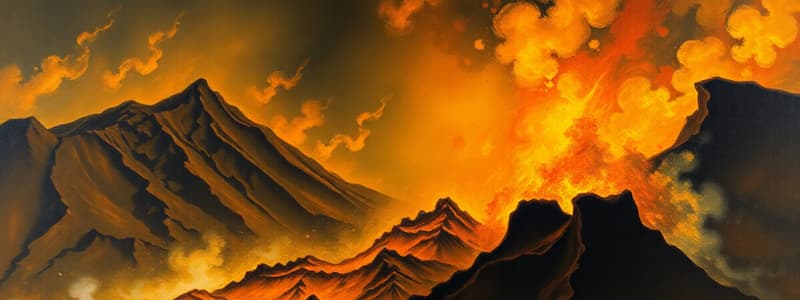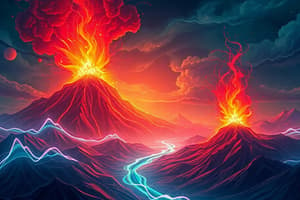Podcast
Questions and Answers
Which of the following best describes the epicenter of an earthquake?
Which of the following best describes the epicenter of an earthquake?
- The point within the Earth where the earthquake originates.
- The point on the Earth's surface directly above where the earthquake originates. (correct)
- The location where seismic waves are first detected.
- The fault line where the Earth's crust breaks.
The Richter scale accurately measures the total energy released by all earthquakes, regardless of their magnitude or duration.
The Richter scale accurately measures the total energy released by all earthquakes, regardless of their magnitude or duration.
False (B)
What is the name of the instrument used to detect and measure seismic waves?
What is the name of the instrument used to detect and measure seismic waves?
seismometer
Most earthquakes occur along __________, which are deep fractures in the Earth's crust.
Most earthquakes occur along __________, which are deep fractures in the Earth's crust.
Match each term with its correct description:
Match each term with its correct description:
According to the content, what causes the release of energy that results in earthquakes?
According to the content, what causes the release of energy that results in earthquakes?
If an earthquake measures 6.0 on the Richter scale, how much more energy does an earthquake measuring 8.0 release?
If an earthquake measures 6.0 on the Richter scale, how much more energy does an earthquake measuring 8.0 release?
The Moment Magnitude Scale (Mw) is less accurate than the Richter scale for measuring large earthquakes.
The Moment Magnitude Scale (Mw) is less accurate than the Richter scale for measuring large earthquakes.
Explain the relationship between tectonic forces, frictional forces, and the occurrence of earthquakes.
Explain the relationship between tectonic forces, frictional forces, and the occurrence of earthquakes.
Insanely difficult: Which statement accurately describes the primary limitation of the Richter scale (ML) and the compensatory advantage of the Moment Magnitude scale (Mw)?
Insanely difficult: Which statement accurately describes the primary limitation of the Richter scale (ML) and the compensatory advantage of the Moment Magnitude scale (Mw)?
What geological feature is the intersection between a fault and the Earth's surface?
What geological feature is the intersection between a fault and the Earth's surface?
The Richter scale is the most accurate measurement for earthquakes of all magnitudes.
The Richter scale is the most accurate measurement for earthquakes of all magnitudes.
What instrument is used to measure seismic waves?
What instrument is used to measure seismic waves?
The point on the Earth's surface directly above the focus of an earthquake is called the ______.
The point on the Earth's surface directly above the focus of an earthquake is called the ______.
Match each earthquake-related term with its correct definition:
Match each earthquake-related term with its correct definition:
What is the primary cause of earthquakes?
What is the primary cause of earthquakes?
An increase of 1.0 on the Richter scale represents a 10 times increase in energy released.
An increase of 1.0 on the Richter scale represents a 10 times increase in energy released.
Name one limitation of the Richter Scale when measuring earthquakes.
Name one limitation of the Richter Scale when measuring earthquakes.
Most earthquakes occur along plate boundaries, also known as ______.
Most earthquakes occur along plate boundaries, also known as ______.
If two earthquakes occur in the same location, one measuring 5.0 Mw and the other measuring 7.0 Mw, approximately how many times more energy did the 7.0 Mw earthquake release than the 5.0 earthquake?
If two earthquakes occur in the same location, one measuring 5.0 Mw and the other measuring 7.0 Mw, approximately how many times more energy did the 7.0 Mw earthquake release than the 5.0 earthquake?
Flashcards
Earthquakes
Earthquakes
The shaking of Earth caused by sudden energy release in the lithosphere.
Focus
Focus
The point in the Earth's crust where seismic waves originate during an earthquake.
Epicenter
Epicenter
The point on the Earth's surface directly above the earthquake's focus.
Seismic Waves
Seismic Waves
Signup and view all the flashcards
Fault Line
Fault Line
Signup and view all the flashcards
Seismometer
Seismometer
Signup and view all the flashcards
Richter Scale
Richter Scale
Signup and view all the flashcards
Moment Magnitude Scale
Moment Magnitude Scale
Signup and view all the flashcards
Tectonic Processes
Tectonic Processes
Signup and view all the flashcards
Ground Shaking
Ground Shaking
Signup and view all the flashcards
Parts of an Earthquake
Parts of an Earthquake
Signup and view all the flashcards
Focus vs Epicenter
Focus vs Epicenter
Signup and view all the flashcards
Richter Scale Limitations
Richter Scale Limitations
Signup and view all the flashcards
Moment Magnitude Scale Accuracy
Moment Magnitude Scale Accuracy
Signup and view all the flashcards
Tectonic Forces
Tectonic Forces
Signup and view all the flashcards
Stress Release in Faults
Stress Release in Faults
Signup and view all the flashcards
Study Notes
Earthquakes and Volcanoes
- Earthquakes: Sudden shaking of the Earth's ground due to energy release in the lithosphere.
- Focus: Point in the Earth's crust where seismic waves originate.
- Epicenter: Point on the Earth's surface directly above the focus. Shaking is strongest near the epicenter. The further from the epicenter, the weaker the shaking.
- Seismic Waves: Waves of energy that travel through the Earth's layers after an earthquake.
- Faults: Fractures in the Earth's crust where rocks move. Most earthquakes occur along faults. Tectonic forces cause rocks along faults to move. Friction can lock the rocks, build up stress and cause the rocks to eventually snap or move suddenly, releasing energy in the form of seismic waves.
- Tectonic Processes: Cause earthquakes by pushing rock, which builds up stress that causes rocks to move resulting in seismic waves. Plates on the Earth's crust can slide past each other or collide.
- Plate Boundaries: Where plates meet; generally associated with most earthquakes and volcanoes.
Measuring Earthquakes
- Seismometer: Sensitive instrument that records ground vibrations (earthquakes). Measures the height of the largest wave.
- Seismic Waves: Measured to determine earthquake magnitude. The height of the largest wave.
- Richter Scale (ML): Measures earthquake magnitude based on the largest seismic wave amplitude. Logarithmic scale (increase of 1 magnitude = 32 times more energy). It uses the maximum seismic wave amplitude rather than the total seismic energy released.
- Moment Magnitude Scale (Mw): Measures earthquake magnitude based on the total energy released during the earthquake. More accurate than the Richter Scale, especially for large earthquakes. More accurate, especially for earthquakes of magnitude 8 and above.
Earthquake Magnitude
- Moment Magnitude Scale (Mw): Estimates energy released during an earthquake, based on the total energy released, rather than just the largest seismic wave. It is usually calculated from the measurements of seismic waves.
- Richter Scale (ML): Measures earthquake magnitude based on largest wave amplitude, less accurate for larger earthquakes. Limitation: The Richter scale might underestimate larger earthquakes, as it focuses on the largest wave, and not the total released energy from a long-lasting earthquake. (logarithmic scale; each whole number increase in magnitude corresponds to a 32-fold increase in energy)
- Magnitude: Describes the size of an earthquake. Larger magnitudes imply more energy released. Magnitudes using Mw are generally more accurate than those using ML when measuring larger quakes.
Studying That Suits You
Use AI to generate personalized quizzes and flashcards to suit your learning preferences.




